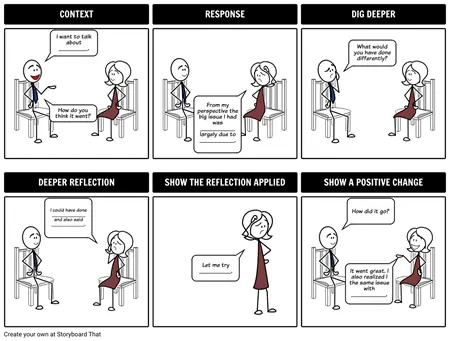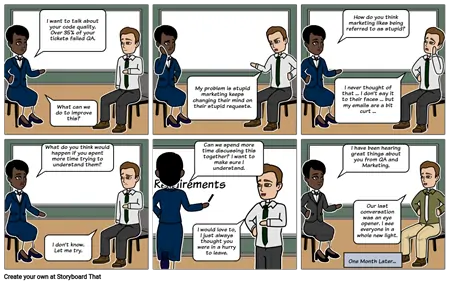Difficult Conversation Framework: Context – Approach – End Goal

A reality of working with people is the periodic need for difficult conversations. Using storyboards allows the author to more easily predict how the other person will respond due to the conversational nature of the storyboard format. More time spent planning increases the chance of a successful resolution. Storyboards are also helpful when mentoring someone: walking them through a difficult conversation to help them see both sides of a situation.
Difficult Conversation Framework: Context – Approach – End Goal
- Context: Why is the conversation happening?
- Approach: Key bullet points and tone.
- End Goal: What does the other person say after hearing your argument?
Pro Tip: Sharing your storyboard with a third party often helps tone down the approach from confrontational to collaborative.
Framework Templates
Storyboard Examples
How Tos about How to have Difficult Conversations as a Mentor
How can I help students practice difficult conversations using role-play?
Set up role-play scenarios that reflect real-life classroom challenges. Assign roles, provide context, and encourage students to use the difficult conversation framework. This allows students to safely rehearse strategies and build confidence in managing tough talks.
Guide students to choose relevant conversation topics.
Encourage students to reflect on recent conflicts or misunderstandings in their lives. Have them brainstorm situations where a difficult conversation might help. This makes the practice meaningful and relatable.
Model effective communication for your class.
Demonstrate a sample difficult conversation using the storyboard framework. Show how to address context, approach, and end goal respectfully. Students learn best by seeing positive examples in action.
Facilitate peer feedback after role-plays.
Invite students to share what worked well and what could improve after each role-play. Encourage constructive, specific feedback. This builds a supportive environment for skill growth.
Celebrate growth and effort in communication skills.
Recognize students who demonstrate empathy, clarity, or collaboration during difficult conversations. Positive reinforcement motivates ongoing practice. Highlighting progress helps students value these essential skills.
Frequently Asked Questions about How to have Difficult Conversations as a Mentor
What is the difficult conversation framework and how can I use it in my classroom?
The difficult conversation framework is a structured approach that includes Context, Approach, and End Goal. Teachers can use it to plan and navigate challenging discussions with students, parents, or colleagues by clarifying the reason for the talk, choosing the right tone, and aiming for a positive outcome.
How do storyboards help with preparing for difficult conversations?
Storyboards visualize the flow of a conversation, allowing educators to anticipate responses, refine their approach, and practice empathy. This method helps make discussions more collaborative and less confrontational, increasing the likelihood of a successful resolution.
Can you give an example of using the context–approach–end goal framework for a student conflict?
For a student conflict: Context: Address a disagreement over group work; Approach: Use calm, clear bullet points to discuss behaviors; End Goal: Both students agree on steps to improve teamwork. Storyboards can help map out each step.
What are the best ways for teachers to plan difficult conversations with parents?
The best way is to use the context–approach–end goal framework: define the purpose, plan key points and tone, and set a constructive outcome. Sharing a storyboard with a colleague can also help refine your approach for greater effectiveness.
Why should K-12 educators use storyboards for mentoring or conflict resolution?
Storyboards help educators mentor and resolve conflicts by visually presenting both sides of a situation. This makes conversations easier to understand and improves empathy, leading to better solutions in challenging scenarios.
© 2025 - Clever Prototypes, LLC - All rights reserved.
StoryboardThat is a trademark of Clever Prototypes, LLC, and Registered in U.S. Patent and Trademark Office



